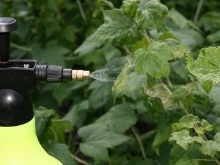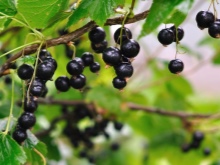Features of spring currant processing

Spring processing of currants plays an important role in the proper development, growth of shoots and the protection of this berry crop from diseases and pests. When deciding how to spray the bushes, you can choose completely different options. In early spring, boiling water is used, in April - Bordeaux liquid and other chemicals, and it is better to draw up a calendar of such events in advance.



Timing
Spring processing of black, white and red currants is always of particular importance. It was during this period that sap flow begins, and with the melting of snows, insects are also activated. High humidity in April leads to the spread of viruses and fungal infections. As atmospheric temperatures rise, this can easily lead to infection of an entire garden.
Shrubs are especially vulnerable to disease and parasite attacks. That is why sanitary measures are taken as early as possible. It is best to start acting when the average atmospheric temperatures reach +15 degrees Celsius. For each region, this moment falls on its own time. For the middle zone, the optimal time comes in the 3rd decade of March, and in the south - at the end of February, Siberia and the Urals please with warmth only by the end of April.
Much also depends on what stage of the growing season the shrub is. Usually the best time to process currants is when when the sap flow has not yet begun. Unopened buds reliably preserve young leaves and peduncles that are laid in them under a hard shell. If processing is carried out after the start of sap flow, the shrub can change the timing of fruiting.
Spraying is necessary in good sunny weather, on a calm day. Any processing requires repetition. Usually they take a break of 10 days, this is enough to remove a new population of pests from undestroyed eggs.



How to treat with hot water?
There are a number of processing methods that can protect currants from various hazards. The simplest, environmentally friendly and affordable of them is the use of hot water. On contact with air, steam is generated, which has a disinfecting effect. In addition, heat treatment effectively fights fungal spores. When deciding to water currant bushes from pests with hot water, it is important to take care of the protection of the trunk circle and roots in advance - they are covered with special protective materials.
Boiling water treatment has its own subtleties. It is carried out taking into account the following nuances.
- Before the start of sap flow. It is enough to wait until the snow starts to melt. In emergency cases, the bushes are disinfected in the fall, after the foliage is dropped.
- Sprinkling method. For work, you will need a watering can with a shallow divider, protective gloves. Branch watering ensures the safety of the root system. Viruses, bacteria, insect larvae die on contact with boiling water.
- At a water temperature not higher than 90 degrees... It will have to be measured before sprinkling to avoid bark burns.
- With the consumption of 3-4 liters of water per bush. You can prepare a solution with potassium permanganate by adding a few crystals of the substance to the watering can.
- At a distance of 5-10 cm from the branches... With a wider range of exposure, you can accidentally get boiling water on the roots of the plant.
Preparation is also important. After winter, it is imperative to clear the bush.Remove dried and broken branches, if cone-shaped growths or other deformations are found, they are cut out with a disinfected garden knife. Only after this is the steam treatment started.



Spraying with chemicals
Chemical treatment is a reliable remedy for viruses, pathogenic fungi, insects at any stage of their development. Choosing how to spray currant bushes in early spring, you can act in a complex or selective way. In the first case, the treatment will be preventive. In the second, a mixture is prepared from components aimed at destroying specific pathogens.
Popular means for chemical spraying of currants.
- Bordeaux liquid... Under this name, a fungicidal solution is widely known, consisting of a mixture of slaked lime and copper sulfate. Typically, the liquid is prepared by hand, simply by mixing the ingredients before use, and then diluted with water at a concentration of 3%. From the kidney mite, spraying is performed before the start of sap flow. From anthracnose, rust, all types of spotting, bushes can be treated after the first leaves appear.
- Insecticidal preparations. Usually the currants are most annoyed by aphids, gall midges, leaf rollers, and glassware. Chemicals such as Iskra or Karbofos work well against them. Processing is carried out in warm weather, upon reaching temperature values of at least +15 degrees and until the formation of flower buds. Later, chemical residues can build up in the berries.
- Copper sulfate. Its solution is prepared before use, the powder has a bluish tint, is sold in bags. For preventive purposes, a 1% solution is suitable, the dosage per bush is up to 5 liters. It helps to protect the plant from diseases and is suitable for soil disinfection. Currant processing is performed three times, with a week break between stages.
- Chemical acaricides. A special group of insecticidal preparations is used against aphids and thrips, spider mites. "Aktara" or "Akarin" act on parasitic insects by contact and through absorption into the organs and tissues of the plant. Processing can be carried out from the beginning of flowering to the beginning of the formation of bunches of berries. Spraying is carried out on warm, clear days, when the temperature values on the thermometer are above +22 degrees - so the drugs will work faster.
- Potassium permanganate. The most common potassium permanganate is one of the most effective disinfectants, and can also become an additional source of potassium. Early processing is carried out before bud break, immediately after the snow melts. A crystal of a powdery substance is dissolved in 1 liter of water. The solution is suitable for watering the soil and sprinkling on bush branches.
- Chemical fungicides... They are effective against powdery mildew and other common infections. For example, anthracnose or septoria. To combat these diseases, powerful drugs are suitable - "Topaz" or "Vectra". It is strictly forbidden to use them more than 3 times during the season.
- Urea... Such treatments are more of a preventive nature, but when this substance is combined with copper sulfate, more impressive results can be achieved. Spraying is carried out in early spring, at an air temperature of about +5 degrees. 0.5 kg of carbamide (urea) is dissolved in 10 liters of water. A solution of about 3 liters is consumed per 1 bush.
- inkstone... This crystalline substance is bluish-green in color. If it gets on the leaves, the solution can cause their burns, so spraying is performed in early spring, along bare branches, you can navigate to mid or late April. Such treatment is of a preventive nature, with an increase in the concentration of the substance to 2.5%, you can get rid of insects with the help of ferrous sulfate.
In addition to chemicals, modern agronomists and amateur gardeners also use biological protection agents - these include the drug "Fitosporin" and its analogues. They do not accumulate in the organs and tissues of plants, they are quickly removed from them without causing harm.



Biological treatment
Currant bushes that have entered the period of awakening from winter stagnation, it is best to treat with biological protection drugs. They act selectively, suppressing only certain pathogens of fungal diseases or other infections, and inhibit the reproduction of insects. The composition of such preparations contains beneficial microorganisms and toxins that do not affect the taste and composition of currant fruits.
Shrubs can be treated with the following biological remedies.
- "Lepidocide". An insecticidal preparation that affects the reproductive functions of insect pests. This tool is used in the spring, when the air warms up to + 15-17 degrees, spending about 1/3 of a bucket of solution per bush. Among the insects against which the remedy helps are the moth butterfly, leafworm, spider mite and currant glass.
- Fitosporin-M. Biological product with proven efficacy against most fungal diseases. Helps to eliminate signs of rust, bacteriosis, powdery mildew on bushes. For prophylaxis, the treatment is repeated every 10 days. It is important to choose hours for this in which there is no bright sun, otherwise the effectiveness of the product will be reduced.
- "Bitoxibacillin". A biological product that has the ability to cause intestinal paralysis in spider mites, aphids or caterpillars. The solution is prepared and sprayed over the leaves before flowering.
- Trichodermin. The most effective preparation for antibacterial treatment of currants. Additionally, it has an immunostimulating effect, promotes good growth and development of bushes.
A properly organized spring fight against fungal infections today is carried out using not chemical, but biological preparations. They can sprinkle plants that have already given leaves, without fear of burns.



Traditional methods
There are other means available to absolutely all summer residents. In folk recipes, pharmaceutical preparations are often mixed with water - iodine, potassium permanganate, ammonia. To protect against aphids, it is customary to spray the branches and leaves of currants with soapy water, other insects can be scared away with infusions of herbs and garden plants. The most popular folk methods are worth considering in more detail.
- Soap... The household variety used for washing is prepared using natural fatty acids. To combat aphids and other pests on currant bushes, it will be enough to dissolve 3 pieces of such soap in 10 liters of hot water. The raw material is preliminarily crushed into shavings or finely rubbed. The treatment is most effective immediately after the first leaves appear, then it can be repeated every 14 days.
- Iodine... For gardening, a pharmacy solution of this substance is used at a concentration of 5%. 10 ml of iodine is added to a bucket of water, then the resulting composition is poured into a sprinkler, sprayed onto the bushes from top to bottom. Processing is carried out in early spring, before the leaves appear.
- Soda... Not only acids, but also alkalis have a detrimental effect on the causative agents of fungal infections. The baking soda solution is applied from early spring to flowering by adding 50 g of powder to a bucket of water. The mixture is poured into a garden spray bottle, sprayed over the branches. You can mix this solution with laundry soap.
- Wood ash. In the fight against powdery mildew, wood ash is one of the most effective remedies. Its crushed powder, about 1 kg, is used to prepare the infusion. After mixing the ash with a bucket of water, the mixture is kept for 4 days. The solution is poured into bottles, used to spray currants from the first leaves to flowering.
- Onion and garlic decoctions. These sources of pungent odors work well as a repellant insecticide. Decoctions based on heads of garlic or onion peels do an excellent job with this task. The infusion is prepared concentrated in 1 liter of water, keeping it for a week, and then diluted in a ratio of 1:10. In addition to aphids, such a homemade remedy copes well with thrips and spider mites.
Folk remedies are good for their safety, but their effectiveness is much inferior to modern insecticides. Such solutions are used as a preventive measure. If the bushes are seriously affected by pests or fungal infections, insecticides and fungicides should be used with more pronounced effectiveness.



Useful Tips
The first spring processing of currants is a good reason to stimulate the immunity of the bushes, to awaken them for active vegetation. At this stage, even thermal exposure will be enough for the plant. Moreover, it is the treatment with steam or hot water that allows you to achieve good results in the destruction of kidney mites. You can also replace the watering can with a portable steam generator - it is only important to maintain the required temperature regime.
When choosing a drug, it is worth considering features of the threat to plants... For example, against gall aphids and other parasites that feed on plant sap, only systemic insecticides that penetrate the sap flow system will be effective. Contact agents that are not absorbed into leaves and shoots work better against fungal infections.
When working with contact solutions - Bordeaux mixture, iron or copper sulfate - it is important to choose dry, calm weather... For the preparation of funds, water is used with a temperature of at least +20 degrees. In this case, it is important to carry out processing, paying the greatest attention to the shoots and the places of the lateral branches. If the Bordeaux liquid is applied over a green cone, the solution should be at a concentration of 1%.
At the stage of leaf appearance, before flowering and fruit setting, it is possible to carry out treatments with systemic insecticides that can effectively destroy insects with different types of life cycle, feeding methods. "Aktara", "Aktellik" can easily cope with such a task, but at a later date it is better to switch to biological insecticides.
The waiting period in this case will be about 30 days, this will not interfere with the normal harvest.
















The comment was sent successfully.